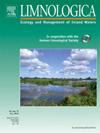有机物质对原生浮游植物和非原生Ceratium的细微影响:一个使用非线性阈值重新分析实地数据的案例研究
IF 2
4区 环境科学与生态学
Q2 LIMNOLOGY
引用次数: 0
摘要
极端气候事件和生物入侵等人为压力导致水质和生物多样性下降。利用2014 - 2018年的5年监测数据,本案例研究旨在确定导致浮游植物生物多样性发生根本性变化的有机物质生态阈值。结果表明:1)随着有机质浓度的增加,本土分类群的数量和丰度呈下降趋势,而入侵分类群的数量则呈增加趋势;2)超过所确定的阈值,对本地总丰度和丰富度(分类和功能)将产生显著的负面影响。在种群水平变化方面,所有敏感类群均为本地类群,而入侵的Ceratium则表现出耐受性,可能是通过异养碳同化。总体而言,沿有机质梯度,原生类群在4.9 mg -1时下降,而Ceratium在5.6 mg -1时显著增加。在群落水平上,原生浮游植物丰度、分类丰富度和功能丰富度均显著下降,高于群落阈值5.25 mg/L。我们呼吁加强对有机质和生物入侵对不同水库的影响的理解,并建议纳入生物量数据以提高生态阈值的更广泛适用性。本文章由计算机程序翻译,如有差异,请以英文原文为准。
Nuanced effects of organic matter on native phytoplankton and non-native Ceratium: A case study re-analyzing field data using non-linear thresholds
Anthropogenic pressures such as extreme climate events and biological invasions have led to declines in water quality and biodiversity. Using a 5-year monitoring dataset, from 2014 to 2018, in an artificial lake designated for drinking water supply, this case study aims to identify ecological thresholds of organic matter that lead to fundamental changes in phytoplankton biodiversity. We hypothesize that 1) native taxa would predominantly decline in frequency and abundance, while abundance of the invasive Ceratium would increase with higher organic matter concentration; and 2) significant negative impacts on native total abundance and richness (taxonomic and functional) would occur above the identified threshold. Regarding population-level changes, all sensitive taxa were native, whereas the invasive Ceratium showed tolerance, possibly through heterotrophic carbon assimilation. Overall, native taxa decline at 4.9 mgL-1 whereas Ceratium significantly increases at 5.6 mgL-1 along the organic matter gradient. At the community-level, native phytoplankton abundance, as well as taxonomic and functional richness, declined significantly above the identified community threshold of 5.25 mg/L. We call for a stronger understanding of the impacts of organic matter and biological invasions across different reservoirs, and recommend incorporating biomass data to improve the broader applicability of ecological thresholds.
求助全文
通过发布文献求助,成功后即可免费获取论文全文。
去求助
来源期刊

Limnologica
环境科学-湖沼学
CiteScore
3.70
自引率
5.90%
发文量
64
审稿时长
3 months
期刊介绍:
Limnologica is a primary journal for limnologists, aquatic ecologists, freshwater biologists, restoration ecologists and ecotoxicologists working with freshwater habitats.
 求助内容:
求助内容: 应助结果提醒方式:
应助结果提醒方式:


